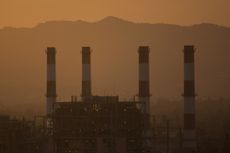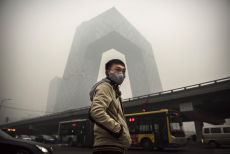The U.S.-India climate change deal: President Obama is on a roll
Two cheers for the U.S.-India climate deal


On his second visit to India as president, Barack Obama scored yet another diplomatic victory, agreeing with Indian Prime Minister Narendra Modi on a series of steps that will cement the commitment by both governments to tackle climate change. While the steps outlined are not sufficient on their own to avert the worst effects of global warming, this weekend's visit is a success, especially when seen in the context of the blockbuster U.S.-China agreement that Obama was able to secure in late 2014. The world's three largest polluters are on the same page in recognizing the seriousness of the climate crisis, even if they are approaching the issue on their own terms and at their own pace.
The specifics outlined in the joint statements coming out of the meetings between Obama and Modi are mainly continuations of prior initiatives. The central conclusion one should draw from the agreements is that both countries got a great deal of what they wanted. For Modi, India received recognition of its admirable efforts to deploy solar power, while avoiding pledges regarding a peak emissions year (which the Chinese agreed to in November) or a future schedule of emissions reductions. With promises by the U.S. to expand its Partnership to Advance Clean Energy (PACE) program, India can be assured that it can count on its relationship with the U.S. to unlock the kind of financing necessary to reach the goals the government has laid out for renewable energy growth.
For the U.S., Obama received assurances that India would participate constructively in building consensus toward a strong agreement in Paris later this year (where the global community will try to hammer out a successor to the Kyoto Protocol), though what that would actually look like remains to be seen. What matters is that, in the wake of the U.S.-China agreement, India is responding to shifting norms by trying to appear proactive and refraining from going out of its way to highlight historic divides between developed and developing countries over responsibility for cumulative greenhouse gas emissions. While it maintains its prerogative to place economic development on a higher pedestal that environmental sustainability in the short term (meaning it will still exploit its domestic coal reserves), over the long term it realizes it has a significant role to play in being some kind of a model of de-carbonization. Hopefully the fruit of this progress will be seen in its intended nationally-determined contribution (INDC) — the master plan for fighting climate change, which India is required to submit by this spring.
Subscribe to The Week
Escape your echo chamber. Get the facts behind the news, plus analysis from multiple perspectives.

Sign up for The Week's Free Newsletters
From our morning news briefing to a weekly Good News Newsletter, get the best of The Week delivered directly to your inbox.
From our morning news briefing to a weekly Good News Newsletter, get the best of The Week delivered directly to your inbox.
The much more significant development appears to be on the nuclear issue, though some specifics are still pending further discussions. U.S. companies have long been reluctant to develop projects in India, because the country's liability laws are so onerous. Individual companies would still have to scrutinize the specific mechanisms underlying the insurance program that is meant to neutralize the bite of the liability law and make decisions about whether it would still be a good idea to move forward on projects, but Obama and Modi have lifted a significant hurdle. Accelerating the deployment of nuclear power in India would have a great deal of climate benefits, since it could, over time, displace coal as the principal source of baseload power, acting as a complement to India's initiatives on solar power, which, absent significant advancements in battery storage, are much more intermittent.
On the larger context of the commitment to do more on climate change, much remains to be seen over the course of this year. The next major raft of announcements will come this spring, when the 195 countries that are party to the United Nations Framework Convention on Climate Change are due to submit their INDCs for tackling greenhouse gas emissions, a commitment that grew out of the Lima conference in December. This process has been strengthened immensely by what the Obama administration has done in Beijing and Delhi over the past three months.
Create an account with the same email registered to your subscription to unlock access.
Sign up for Today's Best Articles in your inbox
A free daily email with the biggest news stories of the day – and the best features from TheWeek.com
Neil Bhatiya is a Policy Associate at The Century Foundation, where he works on issues related to U.S. foreign policy, with a specific focus on South Asia and climate change.
-
 'Colleges warn of punishment for disruptions'
'Colleges warn of punishment for disruptions'Today's Newspapers A roundup of the headlines from the US front pages
By The Week Staff Published
-
 Peter Murrell: Sturgeon's husband charged over SNP 'embezzlement' claims
Peter Murrell: Sturgeon's husband charged over SNP 'embezzlement' claimsSpeed Read SNP expresses 'shock' as former chief executive rearrested in long-running investigation into claims of mishandled campaign funds
By Arion McNicoll, The Week UK Published
-
 The murky role of military contractors in war
The murky role of military contractors in warThe Explainer A civil case against US company has revived debate over the increasing use of private security firms in military operations
By Richard Windsor, The Week UK Published
-
 Approaching Day Zero
Approaching Day ZeroThe Explainer With Cape Town nearing "Day Zero," the world may be seeing a grim portent of a drier future
By The Week Staff Published
-
 America's flood epidemic
America's flood epidemicThe Explainer Severe flooding is becoming increasingly common in the U.S. — and more destructive
By The Week Staff Published
-
 The EPA's changing mission, explained
The EPA's changing mission, explainedThe Explainer After decades of dramatic successes — as well as failures — the Environmental Protection Agency is at a crossroads
By The Week Staff Published
-
 The EPA's changing mission, explained
The EPA's changing mission, explainedThe Explainer After decades of dramatic successes — as well as failures — the Environmental Protection Agency is at a crossroads
By The Week Staff Published
-
 The Paris climate summit: A brief guide
The Paris climate summit: A brief guideThe Explainer More than 190 countries will gather in Paris on Nov. 30 to try to slow climate change. Is it too little, too late?
By The Week Staff Published
-
 China's green revolution
China's green revolutionThe Explainer The world's worst polluter is worried about climate change, and is now the biggest global investor in green technology
By The Week Staff Published
-
 The end of coal?
The end of coal?The Explainer To avoid catastrophic climate change, scientists say, we'll have to abandon the cheapest fossil fuel
By The Week Staff Published
-
 Obama won't be able to repeat his China climate change deal in India. Here's the next best thing.
Obama won't be able to repeat his China climate change deal in India. Here's the next best thing.The Explainer But here's the next best thing
By Sabina Dewan Last updated